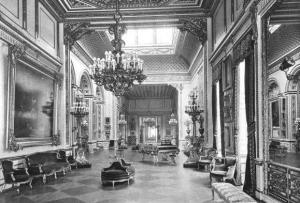“It is arguable that Stafford House was the only true private palace ever built in London, even if it did not surpass Versailles as Wyatt intended.”
Commissioned by the Duke of York, construction began on what was known then as York House. Princess Charlotte had died and HRH Frederick Augustus (1763 – 1827) was thinking he ought to have a palace now that he was heir to the throne. He once marched 10,000 men up a hill only to change his mind and order the lot back down. When York House scarcely had its foundation stone laid, the Duke sacked his architect, Robert Smirke, whose snide remark is noted in the the previous post.The Duke was as indecisive a builder as he was a military leader.
Benjamin Dean Wyatt (1775 – 1825) was appointed to finish the job. He had been urged upon his royal patron by the Duchess of Rutland, who was remodelling her own home, Belvoir Castle (hmm, I sense a subject for a future post). BD Wyatt designed the house to be two story, with Palladium attributes such as a rusticated ground floor and a lofty piano nobile beneath a shallow pediment raised high by Grecian columns.
It remained a shell, however, until it was leased to the Marquis of Stafford. He was also the late Duke’s largest creditor. However, Lord Stafford was unable to finish the house, having passed away as the “richest individual who ever died.”
I pause here briefly to note the Marquis had become Duke of Sutherland in 1833, by virtue of his marriage to the Sutherland heiress. Elizabeth Gordon (pictured below) became Countess of Sutherland when a mere baby. Both were notorious figures in a couple of ways. The couple was briefly imprisoned in France for attempting to aid Marie Antoinette’s escape. They were also responsible for some of the worst of the Highland clearances. The Marquis, appalled at the condition of his wife’s Highland tenants, decided they should be cleared and sent off to become fishermen. It did not go well, like so many well-meaning intentions great powers have for the good of the people.
The 2nd Duke of Sutherland was primarily responsible for the fabulous interior of Stafford House. The state rooms were larger than those at Buckingham Palace. The central hall alone was 80 feet across and the stair rising 120 feet high. White marble Corinthian columns lined the walls.
He added a third story to the house for all the nurseries, schoolrooms, nannies, nurses, tutors, governesses, et al for his eleven (11!) children.
The decorative style has been described as Louis Quatorze — it could easily be termed rococo on steroids. The coffered and coved ceilings were heavily ornamented in the boiseriestyle and painted with lots gilding. Below is one of several ornate ceilings in the house. As if that were not enough, the great Stafford collection of paintings was gathered together in the house, including art brought to England from plundered French aristocrats.
Today, the palace is called Lancaster House. It serves as a government reception site.
Better than being in a dustbin like some other houses we know.




Beautiful house.
LikeLike
Thanks for stopping by, Ella.
LikeLike
Loved the information on this house–and the Staffords. Sounds like an interesting couple. She was certainly beautiful, juding from the picture. And the house–wow! Thanks for the post.
LikeLike
OOps–I didn’t get the entry done–properly :). Elizabeth Gordon–Countess of Sutherland!!–was beautiful. And I suppose I should refer to him as Sutherland, too, not Stafford!! Yikes 🙂 But still an interesting couple!!
LikeLike
Well–I think because it was known as Stafford House at the time, most folks then thought of the couple as being under the aegis of the Leveson-Gower title–Marquess (or Marquis, depending on which contemporary source you like) and Marchioness of Stafford.
LikeLike
How do I get invited to a government reception at the palace Lancaster House?
Lovely house and lovely post. Thanks!
LikeLike
Lancaster House is open on rare occasions throughout the year. You could visit during open house and not have to be bothered with political protocol. Thanks for stopping by!
LikeLike
Gorgeous house! Thanks for telling us more about it,
Suzi Love
LikeLike
I’m glad you like it, Suzi! Thanks for stopping by.
LikeLike
It’s beautiful, and as always, has an interesting history. I’m glad this one survived!
LikeLike
Me, too. Its exterior has greatly changed but the interior features that make it London’s Versailles are all intact.
LikeLike
Pingback: Too Good for that Infamous ‘Whore’ – Bridgewater House « Angelyn's Blog
I have been enormously swamped since the day this was posted, but I was dying to check this out. Wonderful info for those like me who love the houses of the era — and also love to read about the real ton. Thanks, Angelyn.
LikeLike
Pingback: Hearts Through History Romance Writers
Angelyn,sorry to say the Picture you have used to illustrate the story is “Bridgewater House” which is next door to Stafford House and two down from Lancaster House
Good picture though
LikeLike
Oh, dear. I should have stuck with the description that most readily defines Stafford/Lancaster House–its interior. Bridgewater House’s exterior is far finer. Difficult to resist putting in a post.
Thank you, John, for correcting that for us.
LikeLike
Pingback: Regency Furnishings: the Bergère – Angelyn's Blog